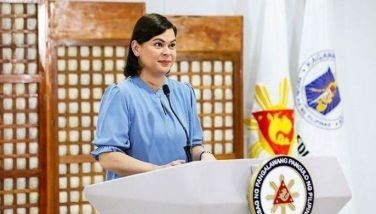‘Supercow’ production now possible year-round
October 5, 2003 | 12:00am
Soon, "supercows" will be a common site in the country’s cattle landscape.
It is now possible to breed this superior animal, which can produce more than 18,000 liters of milk per lactation, thanks to the biotechnology techniques such as embryo transfer (ET) and vitrification.
Embryo is a fertilized egg while vitrification is a quick, deep-freezing of embryo cryopreservation, which allows long-term embryo storage and transport.
Embryo transfer in tandem with super-ovulation is a reproductive biotechnique that involves the use of hormone that stimulates follicle (early stage of egg) to induce a cow to produce more than one egg at a time. Other components are insemination, collection of fertilized eggs from the donor cow’s reproductive tract through surgical or nonsurgical means, and transfer of the embryos to surrogate cows.
A project along this line is now being implemented by the Philippine Council for Agriculture, Forestry and Natural Resources Research and Development (PCARRD) headed by Executive Director Patricio S. Faylon, himself a noted animal scientist, and UP Los Banos-Dairy Training and Research Institute (UPLB-DTRI).
DTRI researchers Dr. Antonio Rayos, Dr. Jose Arceo Bautista, Dr. Demetrio Marcial Jr., and Conrado Oreiro averred that the female calves of superior cows at the DTRI farm can form the foundation herd of quality milking animals in the future. Moreover, their male calves can be further tested to produce an elite herd of bulls for semen production.
From this PCARRD-funded project alone, the country can produce 120 embryos from the top 10 percent of the herd. An embryo costs about $600 (P35,000), thus savings of about $72,000 on an import substitution basis can be realized, the DTRI researchers projected.
Through the project, reported Arlene Obmerga of PCARRD, year-round production of "supercows" is possible.
Expect more farmlands in the far north to be a-bloom with Bt corn in the coming cropping seasons.
Early estimates have it that at least 300 hectares will be planted to the genetically modified (GM) crop, this writer was told by Dr. Zosimo Ma. Pablico of the Mariano Marcos State University (MMSU) in Batac, Ilocos Norte.
Initially, 34 farmers have signified their intention to commercially plant Bt corn, added Dr. Pablico, who is MMSU’s information director and himself a multi-awarded agriculture writer.
The farmers have been encouraged to go all-out in Bt corn planting from the results of the commercial production of this highly improved crop in the latest cropping season.
Through Gov. Ferdinand "Bongbong" Marcos Jr., the Ilocos Norte provincial government provided soft loans to the farmers for the seeds, fertilizers, and cost of irrigation and lease of tractors.
"Based on the results, we will promote it, but we will need the help of the local government units and experts," MMSU president Dr. Saturnino Ocampo Jr. said.
Those who planted Bt corn harvested 61 tons from an aggregate of nine hectares devoted to YieldGard, a hybrid corn licensed under Monsanto Philippines Inc. that carries a gene from Bacillus thuringiensis (Bt), a common bacterium. The BT gene produces a protein that protects the plant from the destructive Asian corn borer.
As reported by Eileen Cardona of PCARRD, the total yield from five hectares in Dingras town was 41 tons, or an average of 8 tons/ha. In Vintas, the four hectares planted to Bt corn yielded 20 tons, at an average of 5 tons/ha.
Much of the first Bt corn harvest were sold to local and out-of-town corn buyers for food mills. Some were catch and fed to farm animals.
Some of the farmers gave testimonials on their bountiful harvest of YieldGard at a media forum organized by Sonny Tababa of the Los Baños-based SEARCA Biotechnology Information Center.
Biotechnology research in acquaculture in the country is off to a good start.
Now spearheading the thrust is the Laboratory for Advanced Aquaculture Technologies set up at the government-hosted Southeast Asian Fisheries Development Center Aquaculture Department (SEAFDEC AQD) based in Tigbauan, Iloilo.
Funded by the Japanese government, the P431-million facility, which was turned over to the government early this year, provides laboratory facilities for advanced aquaculture research. The facilities assist aquaculture technicians in finding better ways of increasing aquaculture production without causing harmful effects on the environment.
Not for long after the Philippines, through Agriculture Secretary Luis Lorenzo Jr., received the laboratory from the Japanese government through its embassy in Manila, the government buckled down to work.
A workshop on biotechnology research was immediately conducted by SEAFDEC AQD headed by Dr. Rolando R. Platon and the Bureau of Fisheries and Aquatic Resources (BFAR) headed by Director Malcolm Sarmiento Jr.
The priority research areas identified to be addressed by SEAFDEC AQD, BFAR, or both jointly are selective breeding, growth enhancement, stock enhancement and husbandry of novel species; disease control; seaweeds and microalgae; and environment-friendly feeds.
The laboratory’s role in aquaculture R&D in the future had earlier been defined by Lorenzo thus: "I urge the researchers and workers from various institution who will be working here to make this laboratory the center of biotechnology for aquaculture not only in the Philippines but also in the whole of Southeast Asia."
It is now possible to breed this superior animal, which can produce more than 18,000 liters of milk per lactation, thanks to the biotechnology techniques such as embryo transfer (ET) and vitrification.
Embryo is a fertilized egg while vitrification is a quick, deep-freezing of embryo cryopreservation, which allows long-term embryo storage and transport.
Embryo transfer in tandem with super-ovulation is a reproductive biotechnique that involves the use of hormone that stimulates follicle (early stage of egg) to induce a cow to produce more than one egg at a time. Other components are insemination, collection of fertilized eggs from the donor cow’s reproductive tract through surgical or nonsurgical means, and transfer of the embryos to surrogate cows.
A project along this line is now being implemented by the Philippine Council for Agriculture, Forestry and Natural Resources Research and Development (PCARRD) headed by Executive Director Patricio S. Faylon, himself a noted animal scientist, and UP Los Banos-Dairy Training and Research Institute (UPLB-DTRI).
DTRI researchers Dr. Antonio Rayos, Dr. Jose Arceo Bautista, Dr. Demetrio Marcial Jr., and Conrado Oreiro averred that the female calves of superior cows at the DTRI farm can form the foundation herd of quality milking animals in the future. Moreover, their male calves can be further tested to produce an elite herd of bulls for semen production.
From this PCARRD-funded project alone, the country can produce 120 embryos from the top 10 percent of the herd. An embryo costs about $600 (P35,000), thus savings of about $72,000 on an import substitution basis can be realized, the DTRI researchers projected.
Through the project, reported Arlene Obmerga of PCARRD, year-round production of "supercows" is possible.
Early estimates have it that at least 300 hectares will be planted to the genetically modified (GM) crop, this writer was told by Dr. Zosimo Ma. Pablico of the Mariano Marcos State University (MMSU) in Batac, Ilocos Norte.
Initially, 34 farmers have signified their intention to commercially plant Bt corn, added Dr. Pablico, who is MMSU’s information director and himself a multi-awarded agriculture writer.
The farmers have been encouraged to go all-out in Bt corn planting from the results of the commercial production of this highly improved crop in the latest cropping season.
Through Gov. Ferdinand "Bongbong" Marcos Jr., the Ilocos Norte provincial government provided soft loans to the farmers for the seeds, fertilizers, and cost of irrigation and lease of tractors.
"Based on the results, we will promote it, but we will need the help of the local government units and experts," MMSU president Dr. Saturnino Ocampo Jr. said.
Those who planted Bt corn harvested 61 tons from an aggregate of nine hectares devoted to YieldGard, a hybrid corn licensed under Monsanto Philippines Inc. that carries a gene from Bacillus thuringiensis (Bt), a common bacterium. The BT gene produces a protein that protects the plant from the destructive Asian corn borer.
As reported by Eileen Cardona of PCARRD, the total yield from five hectares in Dingras town was 41 tons, or an average of 8 tons/ha. In Vintas, the four hectares planted to Bt corn yielded 20 tons, at an average of 5 tons/ha.
Much of the first Bt corn harvest were sold to local and out-of-town corn buyers for food mills. Some were catch and fed to farm animals.
Some of the farmers gave testimonials on their bountiful harvest of YieldGard at a media forum organized by Sonny Tababa of the Los Baños-based SEARCA Biotechnology Information Center.
Now spearheading the thrust is the Laboratory for Advanced Aquaculture Technologies set up at the government-hosted Southeast Asian Fisheries Development Center Aquaculture Department (SEAFDEC AQD) based in Tigbauan, Iloilo.
Funded by the Japanese government, the P431-million facility, which was turned over to the government early this year, provides laboratory facilities for advanced aquaculture research. The facilities assist aquaculture technicians in finding better ways of increasing aquaculture production without causing harmful effects on the environment.
Not for long after the Philippines, through Agriculture Secretary Luis Lorenzo Jr., received the laboratory from the Japanese government through its embassy in Manila, the government buckled down to work.
A workshop on biotechnology research was immediately conducted by SEAFDEC AQD headed by Dr. Rolando R. Platon and the Bureau of Fisheries and Aquatic Resources (BFAR) headed by Director Malcolm Sarmiento Jr.
The priority research areas identified to be addressed by SEAFDEC AQD, BFAR, or both jointly are selective breeding, growth enhancement, stock enhancement and husbandry of novel species; disease control; seaweeds and microalgae; and environment-friendly feeds.
The laboratory’s role in aquaculture R&D in the future had earlier been defined by Lorenzo thus: "I urge the researchers and workers from various institution who will be working here to make this laboratory the center of biotechnology for aquaculture not only in the Philippines but also in the whole of Southeast Asia."
BrandSpace Articles
<
>
- Latest
Latest
Latest
May 14, 2024 - 3:43pm
By Ian Laqui | May 14, 2024 - 3:43pm
April 10, 2024 - 5:12pm
By Ian Laqui | April 10, 2024 - 5:12pm
March 4, 2024 - 3:32pm
By Ian Laqui | March 4, 2024 - 3:32pm
March 4, 2024 - 2:12pm
By Kristine Daguno-Bersamina | March 4, 2024 - 2:12pm
February 17, 2024 - 2:31pm
February 17, 2024 - 2:31pm
Recommended




























